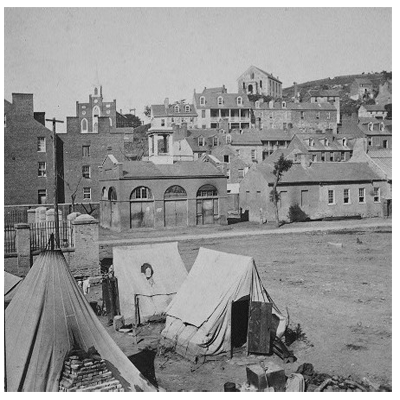


| Article by Steve N. Jackson (v. 1) |
In 1811 American machinist John Harris Hall patented a rifle design that loaded through the breech rather the barrel. This was not the first breach loader to be adopted for military service, the British used a breach loader during the American Revolution for a short while before it was abandoned as expensive and difficult to train on. The Hall rifle though was less complicated and easier to use than the British models.
 The design attracted immediate attention from the United States military, but Hall was unable to produce more than 50 rifles per year from a normal small gunsmith establishment. The problem was that a precision instrument like the Hall rifle took too much labor to produce to the exact specifications needed for operation. At the time there was a definite labor shortage in the United States, and there was a limit to how many skilled metal workers any smithy could hire no matter how much money they were willing to pay.
The design attracted immediate attention from the United States military, but Hall was unable to produce more than 50 rifles per year from a normal small gunsmith establishment. The problem was that a precision instrument like the Hall rifle took too much labor to produce to the exact specifications needed for operation. At the time there was a definite labor shortage in the United States, and there was a limit to how many skilled metal workers any smithy could hire no matter how much money they were willing to pay.
Hall’s solution was not to improve his rifle, but to improve the process by which the rifle was made. Using government funds he moved his process to a riverside site at Harper’s Ferry, where he could have access to a waterwheel. There he built a small factory plant and developed and built a set of metal working machines powered by belt drives. His workers, instead of being skilled but slow smiths, were machinists who worked on a whole series of similar, interchangeable parts. The process even included a quality control step, and while some parts needed hand smithing to correct minor flaws, the overall manufacturing process was automated and streamlined.
The Army, seeing the new gun works at Harper’s Ferry, were as impressed with the mass production as with the rifle. Hall’s armory could turn out 2,000 units per year with less labor that Hall used to use to produce 50 rifles using traditional methods. The rifle’s themselves were well made, accurate, and effective, but not the answer the Army was looking for to arm every soldier. The Hall design did not provide a tight gas seal (which would only be truly achieved in the French Chassepot of the 1860s), and thus drove the same bullet as a muzzle loader at a much lower velocity using the same amount of powder. Breach loaders would be abandoned by most military establishments until the 1850s in favor of the French innovation in muzzle loaders, the Minié ball.
| Citations |
Gilchrist, M. (2006). Patrick Ferguson: A Man of Genius. National Museums Of Scotland. National Museums Of Scotland.
Hounshell, D. (1985). From the American System to Mass Production, 1800-1932: The Development of Manufacturing Technology in the United States. The Johns Hopkins University Press.
Huntington, R. (1972). Hall's breechloaders: John H. Hall's invention and development of a breechloading rifle with precision-made interchangeable parts and its introduction into the United States service. G. Shumway.
Schmidt, P. (1996). Hall's Military Breechloaders. Andrew Mowbray Publishing.
Smith, M. (1980). Harpers Ferry Armory and the New Technology: The Challenge of Change. Cornell University Press.
Watson, E. (1867). The Modern Practice of American Machinists & Engineers. H. C. Baird. University of Michigan Library Reprint, 2009.